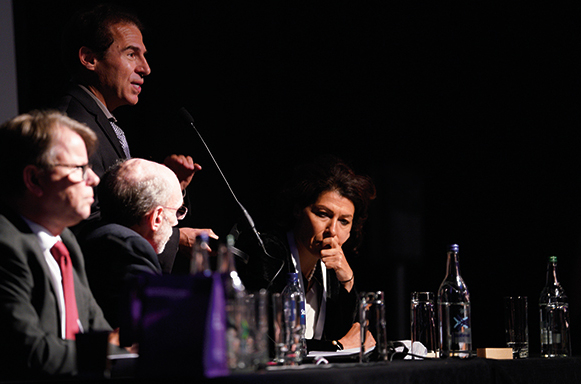WFH meeting Glasgow 2018
WFH meeting Glasgow 2018
New developments and key concepts in coagulation therapies safety, supply, and access
“Prophylaxis is currently the gold standard for hemophilia treatment,” stated Flora Peyvandi, MD, Professor of Internal Medicine at the University of Milan. “The earlier it is started the better the results, but the complexity of prophylaxis may influence adherence to treatment.” Extended half-life (EHL) products have shown the potential to overcome this problem. Real-world clinical evidence of prophylaxis with factor VIII (FVIII) EHL products indicates that 30 to 40 per cent less infusions are necessary, which equates to 20 to 30 per cent lower consumption of FVIII. For factor XI (FIX) EHL products, the data are even more promising with 55 to 65 per cent less infusions necessary, equating to 40 to 60 per cent lower FIX

With the introduction of novel therapies, the bleeding disorders community must be ready for the consequential change in delivery of care. A move towards personalized medicine will increase treatment complexity, because it will be necessary to identify the correct product, patient, dosing and timing. Mark Skinner, former President of the WFH believes shared decision making will also grow in importance. While the patient shares with the healthcare professional (HCP) their values, preferences and goals, the HCP provides all the relevant information, best scientific evidence, and the pros and cons of available treatment options. In the future, this mutual understanding will help decide the best course of action.
With the use of new treatments there are further challenges regarding safety. Daniel Hart, MD, Consultant Hematologist, U.K., outlined short- and long-term safety considerations. Immediate patient safety will depend on the efficacy of prophylaxis and the management of acute bleed, trauma, and surgery management. Hart asked, “What dosing changes will be necessary for bleed treatments? Will there be a fear of over-dosing, and a chance of under-dosing? In the long term, will there be a dangerous accumulation or integration of by-products?” He emphasized the need to fully understand the underlying mechanisms of any new side effects to treatment.
According to David Lillicrap, MD, Professor at Queen’s University, Canada, “The latest FVIII products may show differential immunogenicity due to new non-wild-type amino acid sequences and non-wild-type post-translational modification.” Lillicrap presented some preliminary data that he asked the audience to interpret with caution. Large studies of previously treated patients have not shown an increase in immunogenicity with new FVIII products. However, a 20 to 43 per cent incidence of inhibitors has been reported in trials of previously untreated patients receiving standard recombinant FVIII products. Adequate follow up is necessary for this cohort to explore potential differences in treatment-related immunogenicity.
Several case studies were provided by Manuel Carcao, MD, from The Hospital for Sick Children, Toronto, Canada. Children who switched from standard to extended half-life FVIII needed one less infusion per week. This coincided with an apparent fall in bleed rate. Furthermore, almost all patients appeared to be satisfied with treatment. Similar findings were reported in people switching from standard to extended half-life FIX. This decrease in the number of infusions at a young age suggests that children may benefit the most from EHL factor concentrates.
Glenn Pierce, MD, PhD, WFH medical board member wrapped up the session by discussing the global supply needs of clotting factor concentrates. Of an estimated 490,000 people living with hemophilia worldwide, 57,000 receive more than 4 international units (IU) per capita treatment. To treat this population would require 40 billion IU per year. To provide prophylaxis to 10 per cent trough levels would require 792 billion IU per year. Even though current pricing models do not account for people yet to be diagnosed with hemophilia, this global requirement for factor concentrates represents an unrealistic target. Pierce, MD stated that the licensing of gene therapy will help address this unmet need.

